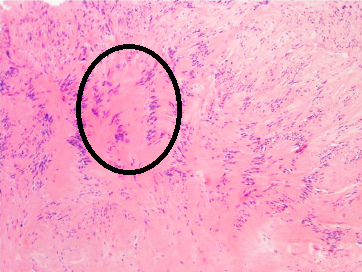Verocay bodies on:
[Wikipedia]
[Google]
[Amazon]
 Verocay bodies were first described by Uruguayan neuro-pathologist José Juan Verocay (born: 16 June 1876, Nuevo Paysandú, Uruguay; died: 1927) in 1910. It is a required
Verocay bodies were first described by Uruguayan neuro-pathologist José Juan Verocay (born: 16 June 1876, Nuevo Paysandú, Uruguay; died: 1927) in 1910. It is a required
 Verocay bodies were first described by Uruguayan neuro-pathologist José Juan Verocay (born: 16 June 1876, Nuevo Paysandú, Uruguay; died: 1927) in 1910. It is a required
Verocay bodies were first described by Uruguayan neuro-pathologist José Juan Verocay (born: 16 June 1876, Nuevo Paysandú, Uruguay; died: 1927) in 1910. It is a required histopathological
Histopathology (compound of three Greek words: ''histos'' "tissue", πάθος ''pathos'' "suffering", and -λογία ''-logia'' "study of") refers to the microscopic examination of tissue in order to study the manifestations of disease. Spec ...
finding for diagnosing schwannoma
A schwannoma (or neurilemmoma) is a usually benign nerve sheath tumor composed of Schwann cells, which normally produce the insulating myelin sheath covering peripheral nerves.
Schwannomas are homogeneous tumors, consisting only of Schwann cells ...
s.
Verocay bodies are a component of "Antoni A" which are the dense areas of schwannomas located between palisading spindle cells found in neoplasm
A neoplasm () is a type of abnormal and excessive growth of tissue. The process that occurs to form or produce a neoplasm is called neoplasia. The growth of a neoplasm is uncoordinated with that of the normal surrounding tissue, and persists ...
s. Two nuclear palisading regions and an anuclear zone make up one Verocay body.
Originally Verocay bodies were called 'neuromas', a term coined by Louis Odier in 1803. The name changed to ‘neuro-fibroma’ under Von Recklinghausen and later in 1935 to ‘neurilemmomas’ under Arthur Purdy Stout. When Harkin and Reed coined the term 'schwannoma' in 1968, Verocay bodies received their present-day name.
Features on histopathological examination include:
1. Eosinophilic acellular area due to overexpression of lamin
Lamins, also known as nuclear lamins are fibrous proteins in type V intermediate filaments, providing structural function and transcriptional regulation in the cell nucleus. Nuclear lamins interact with inner nuclear membrane proteins to form t ...
s.
2. Consisting of reduplicated basement membrane and cytoplasmic processes.
References
Oncology {{oncology-stub